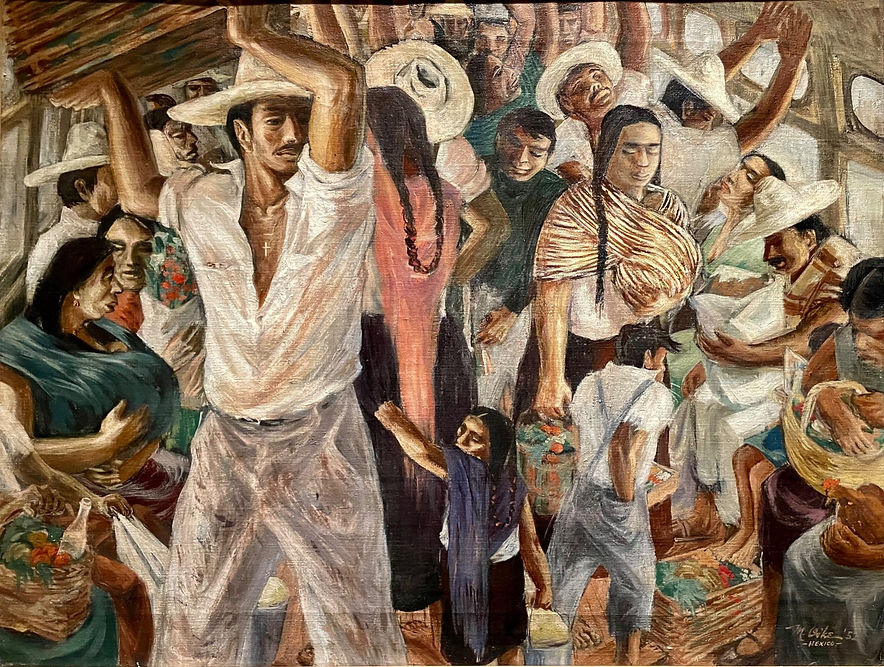
Mary Hoover Aiken (1907-1992)
Mexico
1952
Oil on canvas, 20 x 26 inches. Signed and titled lower right: "M. Aiken '52 / -Mexico-"
References:
Joseph Killorin collection of papers by and about Conrad Aiken, circa 1880-1990, Houghton Library, Harvard University; Anderson, Reed, "Mary Hoover Aiken," in
Tales From the Easel: American Narrative Paintings from Southeastern Museums, circa 1800-1950 (exhibition catalogue, University of Georgia Press, 2004), p. 74; Philpott, A.J., "Mary Hoover's Paintings on Exhibition in Boston," Daily Boston Globe, October 10, 1935; Killorin, Joseph, biographical essay on Aiken posted at askart.com.
Provenance:
Soulis Auctions, Lone Jack, MO, December 5-6, 2014, lot 90; to K. Nathan Gallery, La Jolla, CA; acquired from the foregoing, February 2, 2017.
Notes:
Unlined. Original 4 1/2-inch frame with two labels on verso from F.A.R. Galleries, Inc. of Madison Avenue in New York City (F.A.R. Galleries probably only produced the frame; it was not among the galleries known to represent the artist during her lifetime).

Fig. 1 - The artist at work outside the Aikens' New York City apartment. Photo from Killorin Collection, Houghton Library, Harvard University.
Growing up in Washington, D.C., Mary Hoover was drawn to the arts at an early age. While still in high school, she took drawing classes at the Corcoran Gallery. Although harboring ambitions to become an actress or dancer, she gravitated toward art, studying with Charles W. Hawthorne (1872-1930) and Edward Dickinson (1891-1978) at the Cape Cod School of Art in Provincetown, Massachusetts and taking classes with George Luks (1867-1933) in New York City. After scholarships to Fontainebleau and the Kunstgewerbe Schule in Munich, she travelled to Spain to assist the Spanish muralist and activist Luis Quintanilla (1893-1978) in creating a series of frescoes in the Ciudad Universitaria, Madrid. At risk of becoming embroiled in the mounting political turmoil arising from the chaotic Spanish election of 1933, the artist retreated to the picturesque town of Santa Eulalia on the island of Ibiza, where she spent almost two years painting the fishermen and other colorful characters of the village as well as its landscape.
Hoover’s career accelerated upon her return to New York, where she participated in fourteen solo and group exhibitions within two years and was honored before the end of the decade by the acquisition of two of her Ibiza paintings by the Metropolitan Museum of Art. In 1936, she was introduced to the Pulitzer Prize-winning poet Conrad Aiken (1889-1973) during a visit to Boston. Shortly thereafter, she moved with Aiken and their friend, the British artist Edward Burra (1905-1976), into a rented house in the Charlestown neighborhood of Boston where, according to longtime friend and biographer Joseph Killorin, “Ed painted in the dining room, Mary in the bedroom upstairs and Conrad wrote in the cellar.” In 1937, the trio traveled to Cuernavaca, Mexico, so Conrad could obtain a divorce from his second wife and marry Mary.*
It was on this Mexican journey that the artist witnessed the scene that culminated in the painting Mexico some fifteen years later. Although preparatory sketches are unlocated, a typescript written by Mary in 1938 describes their experience traveling into Mexico by train:
Next day, wonder never ceasing, there was the Rio Grande, and Laredo, where we again had to scuttle through train yards, go through customs, and climb aboard the train for Mexico City. I suppose we could have considered ourselves in second class coaches, since they certainly weren’t Pullmans or first, because there were coaches we had to walk through that exceeded anything any of us had encountered in Italy, France or Spain. For sheer glory of human and animal NOISE, Naples and Barcelona were left in the back row. Baby pigs, baby humans, roosters, hens, dogs, and puppy dogs, peons, peasants of all ages, shapes and sizes, sitting on, or lugging bags, baskets, aprons full of bread, sausages, beans, corn, dead and live rabbits, serapes, pottery, alparagatos, alparegos, and everybody and everything that could yelling, laughing, screeching, crying at a pitch aimed to out-sound everyone and everything else. The seats, and their backs were slatted wood, so that everything small enough to crawl under, over, or in between never had such sport! Probably the only quiet things were the scorpions, tarantulas, and viperos, which to the Mexicanos are like house flies to the gringos up North, i.e., everywhere.**
After their marriage, the Aikens lived in Rye, Sussex, England until 1940, when forced by wartime regulations to return to Massachusetts, where Conrad had been raised by relatives following the tragic murder-suicide that took the lives of his parents at their Savannah home when he was eleven years old. They restored an old farmhouse on Cape Cod, later dividing their time there with residences in New York City and Savannah. Mary continued to exhibit her work at galleries in Boston and elsewhere, receiving favorable reviews.
_____________
* Biographical material is based on obituary written and submitted to askart.com by Joseph Killorin and published shortly after the artist's death in October of 1992 in the Independent, a British newspaper, as well as a telephone interview with Mr. Killorin on February 4, 2017. Killorin was a very close friend of Mary and Conrad Aiken, whose letters he edited and published in 1978.
** Aiken, Mary Hoover, “The Best Painter of the American Scene,” typescript in Joseph Killorin collection of papers by and about Conrad Aiken, circa 1880-1990, Houghton Library, Harvard University, p. 8. The excerpt, from an unpublished article about the British artist Edward Burra, has been edited slightly to correct typographical errors.